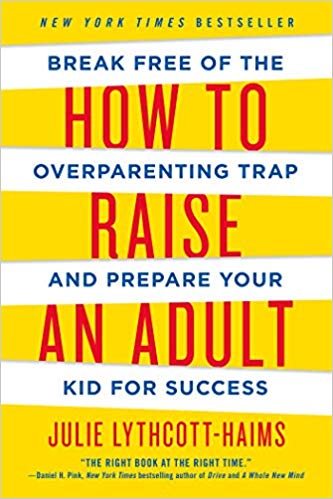 When I was in high school, I was assigned an essay for a philosophy class. As a straight A student, I was devastated when I got a D on the essay.
When I was in high school, I was assigned an essay for a philosophy class. As a straight A student, I was devastated when I got a D on the essay.
My world seemed to collapse, as I realized with embarrassment that I was secretly struggling while my classmates seemed to be doing fine. The fear of failure and embarrassment became so serious that I even considered changing high schools for a less demanding program.
I vividly remember one particular day in which my emotions towards failure got the best of me and a schoolmate found me crying in the hallway. After listening, the classmate asked a simple question: “Is this the first time you feel challenged by an academic task?”
His words hit me hard. I took a deep breath and did a mental scan of previous tasks and homework. I quickly realized that until the philosophy class, I had not struggled academically. Learning was something that came effortlessly, with little hard work needed for positive results. Similar to a natural athlete being able to quickly pick up a new sport, school had always been easy for me.
As I shared this with my classmate, his face lit up and he simply assured me that I would be fine. It was only years later, as a mother, that I was able to look back and realize that his sudden spur of optimism was simply a positive recognition of the important part that failure plays in our lives.
He knew and trusted that once I put myself out there, I would learn how to move forward. He knew that failure was an essential part of success.
So for those who perhaps thought the title of this article was a mistake… it is not!
It is scary to expose our passions and dreams to the world. If our ideas don’t get accepted in the way we want them to, it can have a negative impact on our self-esteem. Failure has the potential to spiral us into negative emotions of despair.
It is only natural that the risk of failure makes us want to avoid it wherever and whenever possible. This natural urge to avoid emotional distress can develop into a huge self-made barrier– which in turn, can prevent us from reaching our full potential.
As a mother, I can see the place that failure has in the development of the essential skills of perseverance, determination, and grit. I see failure as a necessary part of success. Like scientific breakthroughs, success can’t be reached without the wisdom of previous unsuccessful attempts.
We want to see our children use failure as a stepping stone towards success, rather than a roadblock of discouragement. We want our children to feel empowered to try again when they don’t first succeed.
If you share in this desire to teach your child(ren) that failure is necessary and should be celebrated, read on!
Understanding Failure as a Path to Success
 Natural parental instincts tell us to protect our children; which can translate to protecting them from the hardship of failing. Of course we always prefer to see our children succeed in school, sports, or other pursuits. Yet, by encouraging only their success, we are also teaching them it is not okay to fail. We are teaching them to fear and avoid failure at any cost.
Natural parental instincts tell us to protect our children; which can translate to protecting them from the hardship of failing. Of course we always prefer to see our children succeed in school, sports, or other pursuits. Yet, by encouraging only their success, we are also teaching them it is not okay to fail. We are teaching them to fear and avoid failure at any cost.
As parents, we may believe we can protect our children from disappointment and take them on a path to life of success. We may worry that allowing them to fail could translate to lower grades and fewer opportunities–and with that, more pain, anxiety, and sadness.
The hard truth we all must face is that someday our children will encounter failure. Whether we intervene or not, our children will eventually be faced with a situation we won’t be able to prevent.
So what should we do when we see that our kid is going to fail? Do we step in to prevent it or step back and allow the failure– along with the emotions and consequences that it will bring?
Think back on a time in your childhood in which you experienced failure. As adults, we may be able to look back on failure as an essential part of our lives; but the emotions we may remember are likely still unpleasant. How do we teach our children that failure is part of succeeding even while they experience the negative emotions associated with it?
The Science Behind Failure
 When trying to raise our kids to be successful and happy, research says we often overlook the importance of failure. There is an abundance of scientifically-proven connections between overshielding a child from emotional or physical distress and the development of anxiety, depression, and a greater sense of hopelessness and helplessness in adolescence.
When trying to raise our kids to be successful and happy, research says we often overlook the importance of failure. There is an abundance of scientifically-proven connections between overshielding a child from emotional or physical distress and the development of anxiety, depression, and a greater sense of hopelessness and helplessness in adolescence.
Shielding children from distress prevents them from developing coping mechanisms and the maturity necessary to deal with emotions as an adult. Allowing a child to avoid pain may be a quick fix in the moment but ultimately teaches our children that avoidance is an acceptable method of handling big emotions. Failure is necessary for our children to develop emotional intelligence.
Failure is also important for academic and professional success. One of the reasons we may try to prevent our children from having setbacks is because we fear that they will fail academically. We can take comfort in the knowledge that grades and scores are not a predictor of success and happiness!
Many studies show that even intelligence levels are not the most significant predictor of success; rather, characteristics like grit, perseverance, and emotional intelligence better set children up for success. And while there are several theories about the genetic predisposition of non-cognitive predictors of success, scientists agree that most can be learned.
 Allowing our children to fail is one of the ways in which we can encourage our children to learn grit, perseverance, and emotional intelligence. Julie Lythcott-Haims believes we are preventing the development of these noncognitive skills when we over-parent. In her book, How to Raise an Adult, she explains that by over-parenting, we ultimately add stress to our lives while not actually helping our children.
Allowing our children to fail is one of the ways in which we can encourage our children to learn grit, perseverance, and emotional intelligence. Julie Lythcott-Haims believes we are preventing the development of these noncognitive skills when we over-parent. In her book, How to Raise an Adult, she explains that by over-parenting, we ultimately add stress to our lives while not actually helping our children.
Lythcott-Haims explains that when parents believe going to the best colleges is directly linked to their child’s happiness and success, they are implementing what she names a “checklist childhood.” This may include a list of academic successes, activities, scores and grades that their children must have in order to apply for the tiny percent of prestige colleges that will make them successful.
The belief that this is the ticket to success leads to hovering parents–obsessed with grades and assessment scores and continually stepping in to avoid failure. Parents may allow children to avoid other responsibilities for the sake of only focusing on school success. For some parents, it may even mean writing essays or doing homework for them. When we fear that academic failure is going to have a serious impact on the life path of our children, we may feel tempted to help them more than we should.
In reality, getting into the most prestigious college does not guarantee success and happiness. Taking away the chance of failure only gives a false sense of security that failure will not happen. It could also foster a fear of failure, as we communicate through our parenting actions that it is simply not an option.
Letting Our Kids Fail
 Imagine this scenario: you are getting ready to leave for work. The kids are already at school and as you are leaving the house, you see your daughter’s homework on the table. She has been working hard on the assignment and you know she will get in trouble if she doesn’t have it. What would you do?
Imagine this scenario: you are getting ready to leave for work. The kids are already at school and as you are leaving the house, you see your daughter’s homework on the table. She has been working hard on the assignment and you know she will get in trouble if she doesn’t have it. What would you do?
Jessica Lahey in her book, The Gift of Failure, argues that the best thing is to do is… nothing. By letting our child face the natural consequence of forgetting their homework, we are teaching the valuable lesson of responsibility. By failing today, our children will succeed tomorrow.
With her research based on cognitive psychology, growth mindset, and motivation, Lahey describes and supports how small failures offer a learning opportunity that can be highly engaging and educational. The experiences of natural consequences are stored more effectively when they are learned through experience, rather than by a parent telling a child what could happen.
The scientific backing here has to do with neuroplasticity, or the changing and developing of new connections in our brain’s neural network. New connections are most effectively made through real life experience. If we take away the experience of failure, we prevent that neural connection from developing.
For an example of how neuroplasticity works, think of the child development class you likely took as a young adult (prior to having children). You might remember having to work hard in order to memorize the developmental milestones of childhood for exams. After parenthood, the order of milestones would likely be much easier to recite with little studying; as living through the experience of raising children has allowed for a neural connection to develop.
The Problem With Failure
 So can we just conclude that failure is a necessary part of success and always allowing it to happen will lead our children to success? Science says it is a little more complicated than that.
So can we just conclude that failure is a necessary part of success and always allowing it to happen will lead our children to success? Science says it is a little more complicated than that.
It is not surprising that people respond more strongly to negative events than positive ones–physiologically, cognitively, and emotionally. Negative stimuli typically arouse more attention and increase the processing of information. Therefore, it would seem to make sense that failure alone is enough to enable us to learn better.
However, this is not always the case. Several studies have shown that our attention declines when we are exposed to failure and that we actually learn better from other people’s mistakes than our own. Neurography studies done on monkeys have shown that when they fail, their centers for learning in the brain were activated less than when they successfully completed the task.
This would also explain the main criticism of noncognitive predictors of success such as grit and resilience. Children that are faced with a lot of failures and setbacks, especially those from economically disadvantaged backgrounds, don’t necessarily grow to be more successful.
The truth is that failure alone is not enough. Growth really comes from failing the right way!
Failure without a lesson attached will not typically allow our children to move forward. Failing repeatedly in an endless cycle most often indicates that our children may not be learning from mistakes; which can easily lead to feelings of defeat. As parents, we all want our children to learn from failure, to overcome it, and move forward with success.
Our society tends to shed light on failure as a very negative experience. It can prevent us from sharing our ideas, taking chances or trying out new things. Even if we go to great lengths to allow our children to avoid failure, they will eventually experience it anyway. How we help them understand failure can have a great impact on how they will react to that experience.
How Can We Celebrate Failure the Right Way?
 Although it can be scary, the way we can really help our children see failure as a necessary part of success is by normalizing it. Allowing our children to fail when they are still young and we are there to help pick up the pieces, allows us to have some influence on how it can be celebrated in the right way.
Although it can be scary, the way we can really help our children see failure as a necessary part of success is by normalizing it. Allowing our children to fail when they are still young and we are there to help pick up the pieces, allows us to have some influence on how it can be celebrated in the right way.
Now that we are ready to allow failure into our lives, let’s get some ideas on how to celebrate it in the right way!
#1: Change Our Own View of Failure
Before we can help our children overcome the view of failure as bad, we must be able to model the same behavior in ourselves. We can start this process by writing down our fears and recent failures or by talking to a trusted friend who will be honest with us about the areas we may need to work harder.
Research has found that how a child experiences failure depends largely on the parent. Parents who experience failure as a negative experience more often focus on the success and abilities of their children rather than on their learning process and effort. These children more often experience intelligence as fixed. If we see failure as something debilitating, we may unintentionally communicate that to our children.
For parents who struggle to handle failure in a positive way, it can be helpful to focus on one small challenge at a time. This could include a specific challenge that has been a struggle or could even mean creating one simply for the sake of modeling.
For example, if our child is an exceptionally good skateboarder, we could spend an afternoon allowing our child to teach us. Chances are that most non-avid skateboarding adults will be able to quickly show their child how failure looks! Even a “staged” opportunity can be a great model of how to turn failure into a source of fun, laughter, and learning.
#2: Focus on Growth Mindset
 A fixed mindset is the belief that abilities are either given or not given. It is the belief that some things we can not learn because they are not for us. A fixed mindset makes it difficult for children and adults to take risks; most individuals with a fixed mindset will go to great lengths to avoid exposing themselves to the possibility of failure.
A fixed mindset is the belief that abilities are either given or not given. It is the belief that some things we can not learn because they are not for us. A fixed mindset makes it difficult for children and adults to take risks; most individuals with a fixed mindset will go to great lengths to avoid exposing themselves to the possibility of failure.
A growth mindset, however, allows for failure as a tool for growth. A growth mindset is the belief that what we are today is not what we will be tomorrow: what we don’t know is only what we don’t know RIGHT NOW.
Any parent who has adopted a positive parenting outlook in their parenting style can attest to the benefits of a growth mindset. However, accepting failure simply as a part of the growth mindset process can be a bit tricky!
Parents can help their children develop a growth mindset acceptance of failure by:
- Teaching our children about brain development and learning. We can explain how our brains are a network of neurons that can change when we put in effort. The strength of a connection in the brain is comparably as strong as the amount of effort we put in. Every skill, from reading to running, is developed with this same process.
 While an athlete trains his muscles, brains need to be trained to read, write a philosophy essay or accept a positive outlook on failure. Children who have an understanding of how they can contribute to the growth of their own brain are often more willing to contribute to it. This could be as simple as conversation, small reminders, or reading a book such as Your Fantastic Elastic Brain.
While an athlete trains his muscles, brains need to be trained to read, write a philosophy essay or accept a positive outlook on failure. Children who have an understanding of how they can contribute to the growth of their own brain are often more willing to contribute to it. This could be as simple as conversation, small reminders, or reading a book such as Your Fantastic Elastic Brain. - Talking with our children about the differences between growth mindset and fixed mindset. A person with a growth mindset looks at challenges as an opportunity and failure as a chance to learn. Fixed mindset people believe they are limited with their abilities and tend to stick to only what they know. People with a growth mindset love to see other people thrive, while people with a fixed mindset are usually envious of the success of others.
 Using conversations, videos, or books (such as Making a Splash)to explain these differences to children will allow them to better self-recognize their own thoughts as they face failure. It might even lead to siblings or classmates reminding each other to have a growth mindset!
Using conversations, videos, or books (such as Making a Splash)to explain these differences to children will allow them to better self-recognize their own thoughts as they face failure. It might even lead to siblings or classmates reminding each other to have a growth mindset! - Finding real life moments relevant to our child’s life to use as a teaching tool. Perhaps our child did not want to go to dance class because they weren’t as good as others, but they worked hard and eventually loved going to practice. Perhaps our child showed apprehension as they began a new science unit, but then realized that they really enjoyed the topic and looked forward to class every day.
We should not let these experiences pass without acknowledging them with our children! Utilizing real life struggles to help with recognition of mindset pulls on already developed neural pathways that can make it easier for children to associate past struggles with the need of a future mindset.
#3: Stay Away from Comparisons
 It is normal for children to compare themselves to others–it’s normal for all humans to do this! We can see this through the imitation that young children often demonstrate, as they try to look and say the same things as the adults around them.
It is normal for children to compare themselves to others–it’s normal for all humans to do this! We can see this through the imitation that young children often demonstrate, as they try to look and say the same things as the adults around them.
While comparing ourselves to others may always happen to some degree, we can also encourage our children to focus on themselves. Reality is that there will almost always be someone better than us (or our children) at any given skill. The only person we should really ever want our children to compare themselves to is…themselves! We can encourage this shift in the comparison game by:
- Keeping track of the development of a certain skill or keeping a diary of milestones. This could include milestones based on sports activities, school grades, reading words, or any other skill set.
- Avoid comparing our child to other children. This can be a difficult reflex to avoid, particularly between siblings. Rather than making comparisons across children, we can focus on pointing out the improvements we’ve seen within each child–such as “wow, you did a much better job of cleaning your room up this week than you did last week!”
- Encouraging our children to think about the abilities of others as a result of effort and not fixed ability. If our child attempts to compare themself to a peer, we can gently redirect them to compare hard work, rather than talent.
- Acknowledging that differences in passion can create differences in ability. It’s natural for our children to want to put more effort into activities that they have a passion for.
- Recognizing that it is normal for performance to fluctuate. A track athlete who wins an event could come in second in the same event another day. This example can be generalized to success in almost every skill and activity.
#4: Include Failure in Everyday Conversation
Failure is usually a taboo subject. As parents, we may not talk about it because it could create a bad self-image if we parade our failures in front of our children. However, it is this silence that can make failure even more threatening and intimidating in the eyes of a child.
Instead, we should talk to our children about our failures, encouraging them to not internalize or globalise failures. Internalizing failure usually translates to an inability that can’t be improved–or a fixed mindset.
By globalizing failure, we communicate that the failure is a result of circumstances only out of our control. Instead, we can emphasize that failure can be the result of many things; all of which we have some power to take some control of.
For example, a child who says that they failed their test because they can’t learn a particular subject, can be gently reminded that putting in more effort may result in a change in knowledge. There is no better way to encourage our children to think like this than modeling how we process our own failures to change our effort!
#5: Celebrate Failure as a Learning Opportunity
 This skill does not come easy to most children…it likely does not come easy for most of us adults! Part of adopting a growth mindset attitude towards failure is seeing it as an indicator that we have tried something new. Failure can be fun and exciting when presented that way!
This skill does not come easy to most children…it likely does not come easy for most of us adults! Part of adopting a growth mindset attitude towards failure is seeing it as an indicator that we have tried something new. Failure can be fun and exciting when presented that way!
We can make sure our children hear and see this more often by:
- Encouraging our children to think of all the lessons they gained through an experience. As they grow more excited to share this part of failure, we should get excited about what they are telling us!
- Making up an exciting family tradition over discussing failures. Sarah Blakely, entrepreneur and founder of Spanx, says her father encouraged her and her brother to talk at every dinner time about one thing they did successfully that day and one thing they did unsuccessfully. While this felt initially uncomfortable, it became an amazing way to celebrate effort as a family and she has continued this tradition with her son.
- Encouraging our children to write a diary about their failures. Sarah also shares how her father encouraged her to write in a diary when she felt disappointed about the outcome of an experience. It helped her not only learn from her mistakes but redefined her view on failure as something that is not fixed and can be overcome by effort.
- Hanging a reminder of growth mindset over your child’s desk, focusing on how abilities can always be changed.
#6: Share the Failures of Role Models
 From JK Rowling to Spiderman, all successful people (both real and fictional) have stories of failure. It’s easy to get caught up in the “hero” story and only share the successful moments of historical figures, fictional heros, or current-day role models.
From JK Rowling to Spiderman, all successful people (both real and fictional) have stories of failure. It’s easy to get caught up in the “hero” story and only share the successful moments of historical figures, fictional heros, or current-day role models.
This part might require a bit of research on our child’s favorite superhero or real-life idol. Emphasizing the failures of that figure, as well as the perseverance and effort needed to be successful, can potentially have more influence on our children than our simple words of encouragement.
Here are some examples of famous failures:
- Michael Jordan is one of the most successful basketball players of all time, yet he was kicked out of his high school basketball team. He once said for Forbes: “I’ve missed more than 9,000 shots in my career. I’ve lost almost 300 games. Twenty-six times I’ve been trusted to take the game-winning shot…and missed. I’ve failed over and over and over again in my life. And that is why I succeed.”
- Walt Disney was fired from the Kansas City Star because his editor felt he “lacked imagination and had no good ideas.” After that, his first company had to be closed because he could not pay for rent. He did not give up and he became one of the greatest animators of all time.
- JK Rowling was rejected by all 12 major publishers in the UK for her Harry Potter manuscript. A small publisher house, Bloomsbury, eventually accepted it but with a very small advance.
- Oprah Winfrey was fired from her first job as a TV journalist for being “unfit for television.”
#7: Celebrate Effort, Not Success
Praising our child’s effort is easy when it involves a skill that is not a strength for them; but even when our children are very good at something, we should focus on their effort rather than their talent.
If our excitement of having a child with a great talent causes us to praise only their success in that area, we end up overlooking the effort and failures that are behind every achievement. When faced with an obstacle that requires skills that do not come as naturally, our children may be too focused on the outcome to appreciate the effort that comes with improvement.
Successes and failures have a role in our children making their own path through life. As parents, it is not our job to create their path for them. Rather, we should strive to embark on the turbulent journey with them; gently guiding and offering our empathy along the way. Children are often more resourceful and resilient than we give them credit for… even when it comes to handling failure with grace!
The 2-Minute Action Plan for Fine Parents
As you begin your journey to celebrate failure, take a few minutes to assess your current view of failure and the place it has in the development of skills in both yourself and your children. Think about or journal about the following:
- What are your personal feelings about failure? How does it make you feel and what fears do you have about it? Have these fears ever prevented you from trying something new or being your best self?
- Think about some recent specific times in which you faced failure. How did you react to it and what may your children have witnessed about the way in which you handled it?
- What are your personal fears about your children failing at something? What has your praise in the past been focused on–effort or outcome?
- What is one thing you could commit to saying out loud about failure to model a change in mindset to your children?
The Ongoing Action Plan for Fine Parents
Once you’ve done a self-evaluation of your current view of failure and the mindset that you see your children have about it, you are ready to move forward with celebrating failure! There are many ways to make this commitment, including:
- Helping your child celebrate failure by using a notebook to write down motivational quotes for them and encouraging them to journal their failures as a way to learn from them.
- Making time at dinner once a week to discuss all the things that didn’t go as planned and make sure you praise all the effort your child put into those projects.
- Working together to improve on a recent failure. You and your child can choose an area and make the commitment to each other to work on that one area; making time to report to and celebrate progress with each other. Go for that one project you never before dared to tackle and encourage your child to do the same!
Leave a Reply